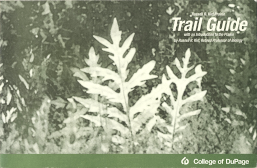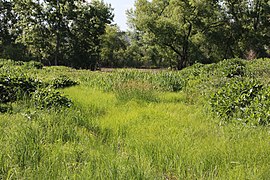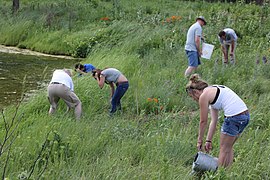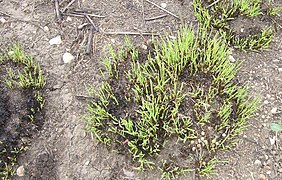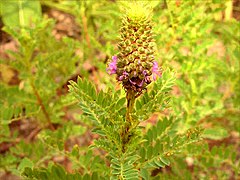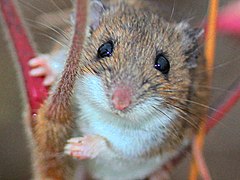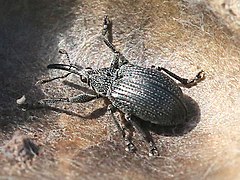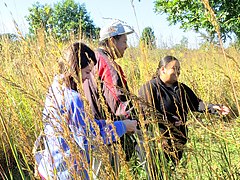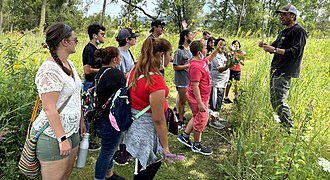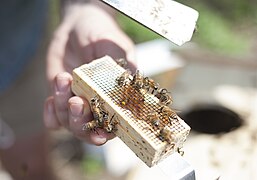| Russell R. Kirt Prairie | |
|---|---|
 | |
| Location | Glen Ellyn, Illinois |
| Coordinates | 41°50′24″N 88°04′33″W / 41.84000°N 88.07583°W |
| Area | 18 acres (7.3 ha) |
| Established | 1984 |
| Named for | Russell R. Kirt |
| Operator | College of DuPage |
|
cod | |
Russell R. Kirt Prairie is a restored tallgrass prairie and savanna within the College of DuPage Natural Areas. [1] A Trail Guide published by the college provides background information and ecological notes. [2] In addition to the mesic prairie and oak savanna, the site also includes a small hill prairie, swale, marsh and wetland areas. [2]: 8
Professor Russell R. Kirt states on the back cover of his book Prairie Plants of the Midwest: Identification and Ecology that he "began restoring prairie in 1974, two years after Ray Schulenberg of the Morton Arboretum introduced him to the prairie". [3] In 1981 he started the restoration project by obtaining grant money from the college's Board Of Trustees, and began collecting native seeds and seedlings from sites within a 40-km radius of the college to ensure local genotypes. [4] In 1984, he reestablished a former farmland and parking lot at the college to prairie with the help of numerous volunteers, including students. The restoration used two methods, either seed broadcast or seedling transplant. [5] Whenever possible, species associations as described by Swink and Wilhelm [6] were planted together.
He monitored the site for at least 16 years, and published his findings at the North American Prairie Conference. [7] [8] After 16 years, the Floristic Quality Index (Index Value in Professor Kirt's papers) in areas restored by either method reached about 30, with no significant difference between the two. [8]: 103
The college Board Of Trustees designated the site as West Prairie-Marsh Nature Preserve in December 1993, and renamed it Russell R. Kirt Prairie in November 1999. [2]: 8
The prairie is located less than 100 meters from the college's Health and Science Center, making it the only sizable restored prairie in the U.S. that is within walking distance of a college classroom building, and it is often used for field study by biology, botany, and environmental science classes. [9] The college offers a Prairie Ecology class that focuses on the tallgrass prairie ecosystem, with extensive hands-on studies in the prairie. [10] [2]: 17 Other disciplines that make use of the prairie resource include earth science, art, and photography. [11]
-
Trail Guide
-
The prairie in July
-
Trail along the savanna
-
Swale and marsh area
-
Prairie Ecology class
Management
Prescribed burns [12] are conducted in the spring and the fall to control weeds and to restore the natural area. [13] In addition, many volunteers are needed to help in hand weeding of invasive plants, seed collection and processing, brush cutting and clearing, and trash removal. [14]
Seeds collected from the prairie are traded with other restoration projects in the region. [15]
-
After a burn in April
-
Prairie Dropseed emerging after a burn in April
Species diversity
The number of plant species identified by Professor Kirt in his studies included 293 native and introduced species. Each species is associated with a coefficient of conservatism (or C value in Professor Kirt's papers) that enable ecologists to determine the Floristic Quality Index (FQI, or Index Value) of an ecosystem. [16] As of 1999 the FQI of the prairie was about 30. [8]: 98
The plant species are classified into 31 plant families. [17] The three most prominent families are Poaceae (grasses), Fabaceae (legumes), and Asteraceae (composites). [18]
Detailed flowering dates of forbs and grasses growing at the prairie can be found in a phenological chart in Professor Kirt's book [3]: xiii–xvii and also in the Trail Guide. [2]: 24–26
Rare species that can be found at the prairie include the federally endangered Dalea foliosa (Leafy Prairie Clover) and the Illinois endangered Nycticorax nycticorax (Black-crowned Night Heron). [2]: 19
-
Dalea foliosa
Ecology
Many ecological studies have been conducted at the prairie by college faculty and others. Target species that have been studied include small mammals such as white-footed mouse, [19] [20] ants, [21] [22] and baptisia seed pod weevil. [23] [24]
Many citizen scientists have used the prairie and surrounding natural areas as a monitoring site for birds, [25] frogs, [26] butterflies, [27] dragonflies, [28] etc. The diversity of flora and fauna at the site is documented at the citizen science portals eBird as a "hotspot" [29] and at iNaturalist as a "place" [30] as well as a "project". [31]
-
white-footed mouse
-
baptisia seed pod weevil
Community education
Since 2016, a full-time prairie manager oversees overall management of the prairie, and also coordinates community education and outreach programs. Guided tours and work days are available to students for service-learning opportunities [32] as well as to the general public. [14] [33]
A meeting point for Prairie tours is the Community Education Fuel Garden [34] where students learn sustainable agriculture. [35]
In 2017, the college installed two honey bee beehives in partnership with The Honeybee Conservancy and Kline Creek Farm [36] to provide pollination and to serve as a learning lab for students and the community. [37]
-
Collecting seeds for service-learning
-
A guided tour
-
Community Education Fuel Garden
-
A beehive box
References
- ^ "Natural Areas". College of DuPage.
- ^ a b c d e f Kirt, Russell R. (1995). Russell R. Kirt Prairie Trail Guide. College of DuPage.
- ^ a b Kirt, Russell R. (1995). Prairie Plants of the Midwest: Identification and Ecology. Stipes Publishing. ISBN 0875635733.
- ^ Lenhart, Jennifer (July 21, 1992). "Pioneer Spirit Fuels Teacher's Prairie Project". Chicago Tribune.
- ^ Kirt, Russell R. (August 5–9, 1990). "Quantitative Trends in Progression Toward a Prairie State by Seed Broadcast and Seedling Transplant Methods" (PDF). Proceedings of the Twelfth North American Prairie Conference. University of Northern Iowa: 183–188.
- ^ Swink, Floyd; Wilhelm, Gerould (1994). Plants of the Chicago Region, 4th Edition. Indiana Academy of Science. ISBN 1883362016.
- ^ Kirt, Russell R. (1997). Warwick, Charles (ed.). "A nine-year assessment of successional trends in prairie plantings using seed broadcast and seedling transplant methods". Proceedings of the Fifteenth North American Prairie Conference. University of Wisconsin Digital Collections: 144–153.
- ^ a b c Kirt, Russell R. (2001). Bernstein, Neil P.; Ostrander, Laura J. (eds.). "A Sixteen Year Assessment of Vegetational Changes in Prairie Seed Broadcast and Seedling Transplant Sites". Proceedings of the Seventeenth North American Prairie Conference. University of Wisconsin Digital Collections: 98–106.
- ^ "Russell R. Kirt Prairie". Wild Ones.
- ^ "Botany (BOTAN)". College of DuPage.
- ^ "Free Tours this Summer of COD's 30-Year-Old Russell R. Kirt Prairies". Patch Media. May 19, 2015.
- ^ Randa, Lynda A.; Yunger, John A. (2001). Bernstein, Neil P.; Ostrander, Laura J. (eds.). "A comparison of management techniques on plant species composition and biomass in a tallgrass prairie restoration". Proceedings of the Seventeenth North American Prairie Conference. University of Wisconsin Digital Collections: 92–106.
- ^ Fresa, Kitt (May 11, 2017). "Honey bees: Pollinating a better future for COD". The Courier.
- ^ a b "Prairie Tours and Work Events". College of DuPage.
- ^ Littlefield, Nicole (March 4, 2020). "Diversifying the Russell R. Kirt Prairie". The Courier.
- ^ Chen, Peter. "Russell R. Kirt Prairie Plant Gallery, College of DuPage". nicerweb.
- ^ Kirt, Russell R.; Tweedie, Henrietta H. (June 1, 1989). Prairie Plants Of Northern Illinois: Identification And Ecology. Stipes Publishing. p. 131. ISBN 0875633404.
- ^ Kirt, Russell R. (1995). Prairie Plants of the Midwest: Identification and Ecology. Stipes Publishing. p. v. ISBN 0875635733.
- ^ Yunger, John A.; Randa, Lynda A. (December 6, 1999). "Trap Decontamination Using Hypochlorite: Effects on Trappability of Small Mammals". Journal of Mammalogy. 80 (4). University of Wisconsin Digital Collections: 1336–1340. doi: 10.2307/1383184. JSTOR 1383184.
- ^ Yunger, John A.; Randa, Lynda A. (December 6, 1999). "Trap Decontamination Using Hypochlorite: Effects on Trappability of Small Mammals". Journal of Mammalogy. 80 (4). The American Society of Mammalogists: 1336–1340. doi: 10.2307/1383184. JSTOR 1383184.
- ^ Petersen, Chris E; Dave, Dhvani G.; Parker, Charise L.; Petersen, Renee E. (April 2002). "Ant-Plant Relationships in a Re-Created Tallgrass Prairie". The Great Lakes Entomologist. 35 (1). Michigan State University Department of Entomology: 27–32.
- ^ Petersen, Chris E; Berta, Christine; Johnson, Dwight T.; Petersen, Barbara A. (2011). "Revisiting the Mound-Building Ant, Lasius claviger, in a Reconstructed Tallgrass Prairie" (PDF). The Great Lakes Entomologist. 44 (1–2). Michigan Entomological Society: 27–33.
- ^ Petersen, Chris E; Gibbs, Jessica L.; Hidalgo, George (2008). "Relationships Between Asynchronous Flowering by Baptisia alba (Fabaceae) and the Seed Predator, Apion rostrum (Coleoptera: Apionidae)" (PDF). The Great Lakes Entomologist. 41 (1–2). Michigan Entomological Society: 19–26.
- ^ Petersen, Chris E; Bauzys, Sharon M.; Speranske, Felicia A.; Petersen, Barbara A. (2012). "The Varying Phenology and Growth Patterns of Baptisia bracteata (Fabaceae) in Reconstructed Prairie" (PDF). Transactions of the Illinois State Academy of Science. 105 (3–4). Illinois State Academy of Science: 79–84.
- ^ "The BCN Survey: Monitoring Chicagoland's Birds". Bird Conservation Network.
- ^ "Calling Frog Survey". Peggy Notebaert Nature Museum.
- ^ "Illinois Butterfly Monitoring Network". Peggy Notebaert Nature Museum.
- ^ "Illinois Odonate Survey". Illinois Odonate Survey.
- ^ "College of DuPage—Russel R. Kirt Prairie". eBird Hotspots.
- ^ "Russell R. Kirt Prairie". iNaturalist Places.
- ^ "Russell R. Kirt Prairie". iNaturalist Projects.
- ^ "College of DuPage Natural Areas". College of DuPage.
- ^ "Prairie Tours at College of DuPage". Naperville Community Television (NCTV17). July 11, 2017.
- ^ Duda, Jennifer (August 6, 2018). "College of DuPage Architecture Students Design, Build and Install Gathering Pavilion". GlobeNewswire.
- ^ Rondeau, Ann (April 11, 2018). "COD's prairie gives students hands-on education". Daily Herald.
- ^ "College of DuPage Brings Honeybees to Campus Natural Area". Daily Herald. June 8, 2017.
- ^ O'Keefe, Brian (June 3, 2018). "Hoping For A Healthy Buzz at COD". WDCB 90.9 FM.

